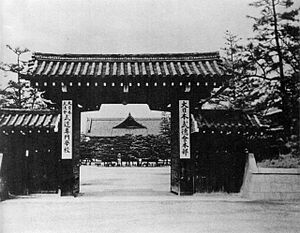| Kancho's essay Back NO,11 On basic Japanese words for Karate HOME | |||
|---|---|---|---|
| Hanshi(範士) Hanshi is a title of honour bestowed on distinguished teachers, usually of ninth or tenth dan rank, in recognition of noble character, discernment and leadership. ‘Han’ (範) is ‘example’ or ‘model’; ‘shi’ (士) is a word for ‘samurai’ or ‘gentleman.’ Hanshi is thus ‘a model in the tradition of the samurai.’  Kyoshi(教士) Kyoshi is ‘gentleman/samurai teacher’ – a title of honour bestowed on teachers of seventh or eighth dan rank. Renshi(錬士) Renshi, again denoting samurai-like qualities (note the recurrence of the kanji 士, is a title of honour bestowed on teachers of fifth or sixth dan rank. ※The origin of these three titles are not old. They were given to the expert of martial arts by "Dai Nippon Butoku Kai (大日本武徳会 Greater Japan Martial Virtue Society;1895-1946). "Dai Nippon Butoku Kai" was dismantled by the United States in 1946 because "Dai Nippon Butoku Kai" had greatly contributed to the militarism of Japan. They are irrelevant to DNBK though some private groups that introduce oneself, "Butokukai" exist now. After that, each sect is giving these titles respectively. Kaicho(会長) The ’Kaicho’ is the head or president of an organisation (not necessarily a martial arts organisation). Whereas ‘kancho’ (see below) is ‘head of the house,’ kaicho is ‘head of the ‘kai’ (会:association).’ The two words can thus mean more or less the same thing, but where an organisation has two chief officers, often one is called ‘kancho’ and the other ‘kaicho. Kancho (館長) Kan (館) is ‘hall’ or ‘house.’ In modern Japanese ‘kan’ denotes a public building with a purpose not necessarily related to the martial arts (e.g. tosho-kan (図書館) is ‘library’; hakubutsu-kan (博物館) is ‘museum’). Kano Jigoro (嘉納 治五郎) (1860–1938), the founder of judo, called his headquarters Kodokan (講道館) (‘the house where The Way is studied’); Shotokan (松濤館) is ‘Shoto’s house,’ ‘Shoto’ being the pen name of Funakoshi Gichin (船越 義珍) (1868 – 1957). Cho (長) is ‘head,’ ‘leader,’ ‘chief.’ In the martial arts the ‘kancho’ is thus the ‘head of the house’ – the chief or overall director of an organisation. Sempai (先輩) Sempai is not a title; the word means ‘senior’ and denotes anyone in the dojo who is senior to you in rank; it is also the customary form of addressing a senior. In relation to your sempai, by the way, you are ‘kohai’ (後輩): junior. Sensei (先生) Sensei is a term used generally to denote a teacher or master (doctors, lawyers or politicians are also called ‘sensei’). It is also a form of address, used after the teacher’s family name (e.g Omoto Sensei), as an equivalent of the English ‘sir.’ Generally speaking, karate teachers are not called ‘sensei’ unless they hold the rank of third dan or higher. Very distinguished or honoured teachers are sometimes referred to as Oh-sensei ( 大先生), which is ‘venerable’ or ‘great’ teacher. Shido-in(指導員) Shidoin is ‘instructor’: usually a teacher of first or second dan rank, though the word is sometimes used of more senior instructors. Shihan (師範) Shihan (‘master.’ ‘expert,’ ‘model’) is a more formal word than ‘sensei’ for a teacher of a traditional art. Shihan-dai (師範代) A Shihan-dai is a senior assistant to the ‘shihan,’ usually of the rank of third dan or higher. Note that ‘dai’ here is 代 (‘representative’), not 大 (‘great’). Soke (宗家) Soke is ‘family head’; the head or founder of a ryu (流) or ‘school’; the authoritative source to which the members of the ryu trace their lineage. Because there are now so many karate ryuha and no strong or single sokeship system, the term has become somewhat debased and is now often not used. Sosai (総裁) Sosai is a word that usually denotes the president or head of a political party. For example, the head of the Liberal Democratic Party of Japan (自由民主党: Jiyu-Minshuto), is called Sosai. As far as I know, the only karate group to use this word is the Kyokushinkai (極真会), as an honorific title of their founder, Oyama Masutatsu (大山 倍達) (1923 – 1994). |